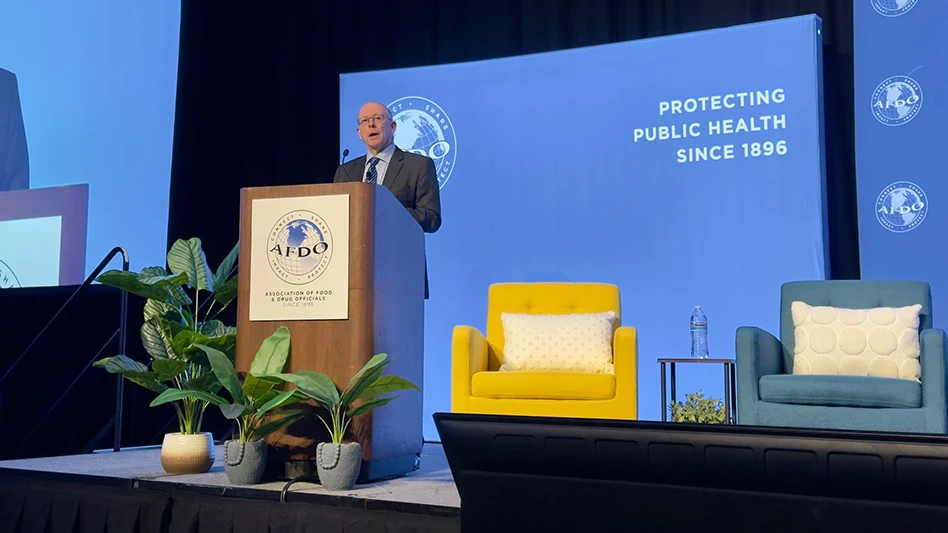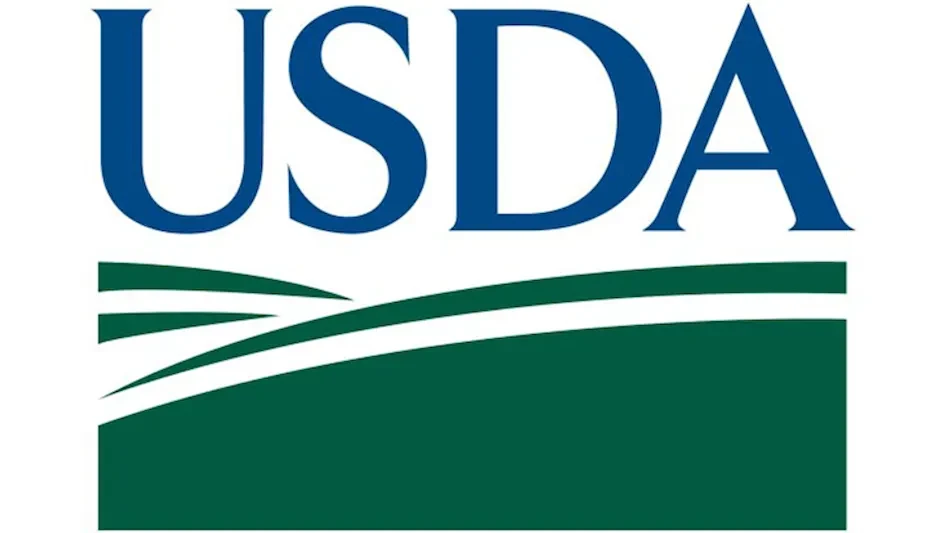
Photo by Jason Brill
Officials from the Food and Drug Association (FDA), U.S. Department of Agriculture (USDA) and Centers for Disease Control and Prevention (CDC) spoke about updates in their respective organizations at the 128th Association of Food and Drug Officials (AFDO) Annual Educational Conference on June 10.
FDA. Jim Jones, deputy commissioner for human foods at the FDA, discussed several topics, including the updated agricultural water rule and the recent H5N1 outbreak.
“I think that the new ag-water rule that we’ve just finalized really does capture what I think of as the essence of this, which is the prevention ethic,” Jones said. “We’re going to all need to work together to achieve the ultimate objective of this rule, which is to prevent a microbial contamination occurring.”
Jones emphasized that it is going to take time to get used to the new system as producers put quality systems in place.
“I expect we’re going to have continuous improvement over time as the regulated community gets better at recognizing hazards [and] as the regulating community gets better at educating,” he said.
Jones also discussed the development of training at the FDA. He said that training resources have gone down, while the need for training has gone up with the increasing number of requirements for inspectors. The FDA has developed a regulatory laboratory training system, which will make sure that federal and state inspectors will be better able to deliver on their requirements, Jones said.
“This is a really thoughtful solution to a challenge that we all face, which is that we are incredibly resource-constrained and that our training resources are going in the wrong direction,” he said.
Jones also spoke about what the FDA is doing in light of the recent outbreak of H5N1, which was discovered in dairy cows two months ago.
“The Food and Drug Administration and our team has been working around the clock for over eight weeks right now to make sure we understand what the risks are,” Jones said. “We have done a ton of work related to the safety of the milk supply, and we are very confident that those supplies are the safest in this country.”
He said that within a couple weeks of the identification of H5N1 in dairy cattle, the organization was doing retail sampling, where they took almost 300 retail samples from across the country.
The first step of analysis in this situation, Jones said, is the PCR study, which found about 20% of retail sales were PCR positive. Each of the 60 positives were put into cultured eggs, which allowed the FDA to evaluate whether any of that virus is viable.
“None of it was. It is what we expected to see,” Jones said. “This gave us a high degree of confidence that pasteurization is effective.”
The team then worked with some state partners, getting samples of local milk to see if pasteurization would be effective in bulk samples that had relatively high viral loads.
Along with performing these studies, the FDA has also been working collaboratively across federal agencies, such as USDA and the CDC. Jones said the agency would like to bring a whole government approach to “what is very clearly a One Health issue.”
“We will continue to be active in ensuring that the dairy is safe,” he said.
Jones also discussed how the FDA is trying to put into place a more systematic and purposeful post-market review process for the chemicals authorized for use in food and food packaging.
Jones said the agency is also working with USDA and state partners to identify practical approaches to reducing levels of chemical compounds and getting them closer to zero. The Closer to Zero program will help reduce exposure to several heavy metals found in agricultural fields, such as lead, mercury, arsenic and cadmium.
“Zero is not attainable, but we’d like to get closer to it in a way that respects our understanding and our knowledge that we want children to be eating fresh fruits and vegetables,” he said. “At the same time, we don’t want them to get exposures to these heavy metals that could be having serious attacks on their health.”
The second speaker from the FDA was Mike Rogers, associate commissioner for regulatory affairs (ACRA) at the FDA’s Office of Regulatory Affairs (ORA), who oversees inspections, compliance, enforcement, field and laboratory operations, import operations and teaching planning across all of the FDA’s regulatory programs. He spoke about the FDA’s plans for reorganization.
“We are involved in the largest reorganization in the FDA’s history. It directly or indirectly impacts thousands of people,” Rogers said.
Part of the new organization will include renaming the Office of Regulatory Affairs to the Office of Inspections and Investigations.
“We used a crowdsourcing campaign, and we asked our primary stakeholders, ‘In a couple of words, how would you describe the Office of Regulatory Affairs?’ Inspections and investigations were the top works that people used to describe ORA,” Rogers explained.
Under the new organization, Rogers said the department is planning on focusing on its core functions, which he calls the three I’s: inspections, investigations and import operations, with an added component of emergency response.
“Our laboratories, even our food laboratories, will go to the Human Foods Program, our medical products laboratories will go to the Office of Chief Scientists, parts of our Office of Partnerships and Operational Policy will go to the Human Foods program, and then that leads the Office of Inspections and Investigations to include dedicated inspectors for human and animal drugs, human foods, animal foods, bioresearch monitoring, which is a cross-programmatic, biologics, medical devices and radiological health,” Rogers said.
There will also be a tobacco branch and a new office under OII, the office of Field Operations and Response, and a small cosmetics team associated with that office.
Rogers said the agency is planning for a stand-up Oct. 1 to get the reorganization moving. Even though things will be changing within the FDA, Rogers said the agency will still be connected to the organization it previously had.
“It’s a new chapter for us, but those organizations will always be connected to our past and our future,” he said.
Rogers also made a point to share a message with the FDA’s state partners, a promise from him in his position at the organization.
“I want to assure you that the states will always be partners with the FDA, and the states will always be part of our regulatory strategy,” he said. “That’s my promise. That I’ll work with the states, now and after the reorganization, to ensure that this great relationship continues, that it’s stronger, that we have predictable resources and it’s a model that we can rely on to carry out our missions.”
CDC. Dr. Robert Tauxe, director of the Division of Foodborne, Waterborne and Environmental Diseases at the CDC’s National Center for Emerging and Zoonotic Infectious Diseases, discussed some reorganization within the CDC, though not to the extent of the FDA’s reorganization. He outlined a few of CDC’s current priorities.
“We’re committed to making progress in reducing the size, scope, severity and recurrence of outbreaks of interrogate fungal infections,” Tauxe said.
The coronavirus response has been consuming activities at the CDC for the past few years, and since it has recently decreased in size, there will be a new, separate coronavirus and other respiratory viruses division within the center, said Tauxe.
The CDC is also looking to modernize PulseNet, a laboratory network that connects foodborne, waterborne and One Health-related illness cases to try and detect outbreaks.
“Our goal is, of course, to empower public health officials, regulators, industry, academia and consumers to drive down the incidence of foodborne infections,” Tauxe said.
After a 41-year career with the CDC, Tauxe retired a week after the presentation. He was awarded the Distinguished Service Lifetime Achievement Award on behalf of the Association of Food and Drug Officials.
USDA. Dr. Jose Emilio Esteban leads the Office of Food Safety at the USDA, overseeing the Food Safety and Inspection Service (FSIS). He discussed a few goals that the USDA currently has, including growing innovation, as the organization has had to cut much of its innovation due to budget constraints.
“We need to figure out ways to do things better, do more and do it cheaper,” Esteban said.
He spoke about the USDA’s effort to work with smaller and mid-size producers, combating Salmonella in chicken and making sure companies provide proper labeling so people know what they are buying.
Esteban also discussed the USDA’s efforts to combat H5N1, which he sees as an animal health issue.
“All the effort that we’re putting into it is preventative in nature for the human side,” he said. “From the USDA perspective, we really want to protect the farmers if we want to protect the animal health.”
Latest from Quality Assurance & Food Safety
- Bird Flu: What FSQA Professionals Need to Know
- Registration Open for 129th AFDO Annual Educational Conference
- Frank Yiannas, Aquatiq Partner to Expand Global Reach of Food Safety Culture
- World Food Safety Day 2025 Theme: Science in Action
- Ancera Launches Poultry Analytics System
- USDA Terminates Two Longstanding Food Safety Advisory Committees
- Catalyst Food Leaders Announces Virtual Leadership Summit for People in Food
- Food Safety Latam Summit 2025 Set for Mexico City





